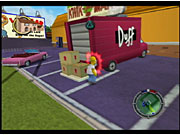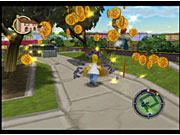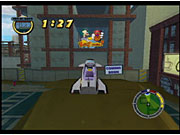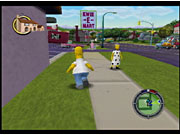It's been over 14 years now since the weekly television debut of The Simpsons, and over that period of time, more than a dozen video games have carried the license of the seemingly inviolable Simpsons franchise. However, with perhaps the sole exception of Konami's 1991 arcade action game, The Simpsons, none of these games have ever managed to really capture the sharp humor and unique personalities of the Springfield universe, and none have really even proved to be much in the way of fun either. Thankfully, this trend has finally come to a close. The latest title to use the Simpsons name is The Simpsons: Hit & Run, an action adventure game that borrows heavily from the gameplay style and design of the recent entries in the Grand Theft Auto series and, in so doing, finally manages to bring the world of the Simpsons to life with proper justice.

The story of The Simpsons: Hit & Run is perhaps a bit convoluted in its design but seemingly in an intentional way. At the beginning of the game, Springfield is being overrun by mechanized bees, mysterious black vans and cars, and an insidious cola that is controlling the minds of the city's residents. In the game, you'll take control of the four core Simpsons family members (Homer, Bart, Lisa, and Marge) as well as resident Kwik-E-Mart proprietor, Apu, to investigate the origins of and motives for all these strange happenings.
As the game follows the same structure as the GTA entries, much of Hit & Run involves a linear series of missions, with a number of exploration elements to boot. The game uses a basic level structure, with seven total levels, each with seven primary missions. Each level in the game is assigned to one specific character. There's one for Lisa, Marge, and Apu, while Bart and Homer get two apiece. Missions are assigned by interactions with the city's various characters. They generally involve collecting and delivering items to other people or locations, racing other characters, and even getting into full-on car combat situations. In actuality, practically every mission in the game is a direct clone of one of the GTA driving missions. However, the lack of originality in the game's mission structuring is more than made up for by the decisively original style of Simpsons humor. The end result is actually very fun.
Each level also has one bonus mission and three non-story-related race missions. Completing both the bonus missions and race missions help you to unlock new and unique cars in the game. This is key, as vehicles are the most important aspect of Hit & Run's gameplay. Hit & Run has a bevy of different cars to choose from, ranging from the more generic and standard looking cars, to a host of different, episode-specific cars that fans of the show are bound to recognize. Each character in the game starts out with his or her own car. Marge has her road-rage-inspiring Canyonero, Homer drives the family sedan, and Bart drives Martin Prince's entry into the Springfield soap box derby, the Honor Roller. These are not the only cars that each character can drive, however, as certain missions will require them to purchase new cars from vehicle merchants located around Springfield. For example, one early mission requires Homer to destroy Mr. Smithers' car before he can get to the power plant to conduct Homer's employee review. So, to do this, Homer purchases the massive Plow King from his good friend Barney. In a pinch, characters can also borrow cars from passing motorists, though these cars are all pretty generic. However, if you can find one of any of the numerous phone booths strewn about the town, you can access any of the different cars in the game. There is a seemingly endless number of different cars to unlock and purchase in the game, from Homer's self-designed car (aptly titled “The Homer”) to Comic Book Guy's beaten-down jalopy to Professor Frink's futuristic hovercar. All in all, the selection of cars should keep you plenty entertained as you navigate the streets of Springfield.

The game's mapping system is denoted by a GTA-esque circular street map that appears in the corner of the screen. It shows where you are in relation to where you need to be. Additionally, there's also a system that works by having arrows appear on the street, pointing out the path you need to follow. In many ways, it's actually a better arrow system than the one used in the GTA games, and it keeps you from ever really getting confused while driving.
Driving isn't the only way to get around Springfield, as you can opt to just run and jump around town, sans vehicle, any time you please. Each character has basic jump, attack, and jump-attack functions. Each can be used to destroy enemies and objects or to explore hidden areas. You can even kick a passerby. Every character can also double-jump, and each also has a unique jumping slam attack. Homer, for instance, can land a pretty hefty butt-stomp when the occasion calls for it. The game also employs an action button, which can be used to activate different objects, like moving platforms and the like.
Outside of the game's storyline and missions, there's plenty of stuff to discover and explore in Hit & Run. Items, money, and hidden gags can be found throughout the city of Springfield. Money comes in the form of coins, which can be obtained by destroying various pieces of the scenery, like soda machines, street signs, and lampposts, as well as the evil mechanical bees that pop up all over the place. Wanton destruction, however, is simply not permitted. Not for long. Cause too much chaos, and eventually you'll end up with the cops on your tail. Your level of rampage is monitored by a meter that appears in the lower corner of the screen. Once it fills up, the police will chase you down. If you're caught, it's a 50-coin fine, which isn't too bad. But if you're careful enough, you should be able to collect coins easily enough without having to constantly deal with the police.

Once you've got the cash, you can obviously buy cars from different characters; but that's not all. Each character also has a different set of outfits that can be purchased at different locations around town. Some of these outfits come directly into play with the game's storyline and are necessary to complete missions. Others are simply there for the fun of it. All the different outfits are throwbacks to episodes of the show, including Homer's muumuu from his brief flirtation with morbid obesity, Marge's cop uniform from her days as a member of Springfield's finest, and Apu's “American” outfit, complete with baseball jersey and oversized cowboy hat.
There are also a number of gags and collectible items strewn about the town. Gags vary from location to location and can be interactive or simply in the background. For instance, walking into the Kwik-E-Mart contains a couple of different gags. Walk to the back, and you find Jasper, or “Frostillicus,” encased within a freezer. Interacting with him will cause him to start shivering, and he'll throw you one of a few different one-liners. On the other hand, if you simply stand near one section of shelves, one of a few different gags will unfold in front of you--including Hans Moleman's mugging by Snake the convict or Krusty the Clown's ogling of an “adult” magazine. You can also find a number of collectible items around town, like wrenches that fix damage to your car and trading cards that reference different items from various episodes of the show. These cards cover a pretty wide spectrum of references. They range from the Mr. Sparkle box (which coincidentally bears Homer's likeness) to the evil Krusty doll that tried to kill Homer in one of the infamous “Treehouse of Horror” episodes. Each card also contains info about the episode in which the item appears and a quotation related to it.
All told, Simpsons: Hit & Run does a really great job of making the world of Springfield an incredible backdrop for an entertaining gameplay experience. If there's one knock against it that keeps it from being a truly superb experience, though, it's that the game just isn't quite as polished as it could have been. One of the less-frequent, but still quite notable, issues in the game is that occasionally bugs pop up that break missions. Occasionally, AI-controlled cars find themselves in stuck situations where they are absolutely unable to get to the required destinations in the allotted time. For example, in one instance, a CPU car actually drove off a cliff, and the game respawned the car in a spot where it could not feasibly get back on the highway. Thankfully, the game lets you restart missions at any time by simply selecting the restart option from the pause menu (another feature that, actually, would have been really nice to have in the GTA series). You always start right back at the beginning point of the mission, without having to drive all the way back to the starting point, so this issue is relegated to a periodic nuisance rather than a serious problem.

The bulk of the game's polish issues lie in its graphics--primarily in the game's somewhat sloppy camera system. When you're driving around, Hit & Run's camera actually works just fine in all three available camera views. However, when you're walking around town, the camera has a pretty heavy tendency to bug out at random. This is especially prevalent in any situation where you get too close to a building or find yourself near any piece of scenery that could possibly get in the way of the camera's set path. You can move the camera with the right analog stick, but in some situations it simply can't be moved to a better angle. Hit & Run is also not immune to some basic frame rate problems, especially when you're driving a heavily damaged car, as the smoke effects used to denote car damage pretty much wreck the frame rate to a fairly significant degree. Clipping is also a problem in many areas--especially any time you get too close to a destructible object.
However, with the bad comes plenty of good as well. While the game may lack polish, it still looks quite good overall. Hit & Run uses a simple, but effective, 3D design that actually makes all of the characters look a bit like Homer from his brush with the third dimension (in another “Treehouse of Horror” episode). The character models aren't heavily detailed, but they look very close to their television counterparts and animate quite nicely.

Significantly more impressive is the amount of detail put into the design of Springfield itself. The different levels of the game are broken up into three specific sections of Springfield, each with its own separate identity. One is the suburban area, which houses the Simpsons' home, another is the city's downtown area, and the last is in and around the city's harbor area. Aside from the obvious landmarks, Hit & Run also hosts a ton of slightly less obvious locales, such as Chester Lampwick's solid gold house, the gigantic Lard Lad Donut statue, and even the now-defunct monorail station. In terms of performance, all three console versions of the game actually run similarly. The Xbox version gets the nod for a slightly smoother look and better overall frame rate. Both the PS2 and GameCube versions look practically identical, though the GameCube version is just a tad less jaggy.
The last and best part of The Simpsons: Hit & Run is its sound, which is really spectacularly done. All of the show's primary voice talents reprise their roles for the game, and the result is an excellent atmosphere created by the game's dialogue. This is also thanks, in no small part, to Hit & Run's writing, as the story was actually penned by writers from the TV show. The cutscenes, in-game dialogue, and even the wacky one-liners are all very snappy and surprisingly topical. Overall, each aspect of the game's dialogue does its job superbly. Hit & Run's music is also extremely well done. Most of the main score feels like it was ripped from some of the best seasons of the show, and the remaining music tracks are all very nice. Additionally, each of the playable characters has his or her own style of background music. For example, when Lisa walks around town, you hear periodic saxophone music, and when Apu is driving, the soundtrack mimics a Bollywood-esque chase sequence, with sitars and electric guitars dueling it out. The only possible complaint to mount against the game's audio presentation is that in certain cases--namely when driving--one-liners have a tendency to repeat a little too often. Hearing Homer yell “Outta my way, jerkass!” is really hilarious, but hearing him yell it on a constant basis can wear a bit thin. This is a very minor complaint in the grand scheme of things though, and, really, it's hard to find much wrong with Hit & Run's audio.

In every way that matters, The Simpsons: Hit & Run is the game that Simpsons fans have been pining for ever since the days of Bart vs. The Space Mutants. It creates the most accurate representation of the world of Springfield ever put into a game, and it manages to make the gameplay surrounding it quite a lot of fun. Additionally, the game's overall sense of humor is delightfully self-referential, and any hardcore Simpsons enthusiast should have a blast exploring the various levels and pointing out the numerous obscure locations and characters that pop up. It's a bit of a shame that the game does have the few bugs and graphical issues that it does, but ultimately, these few problems shouldn't deter you from checking out what is easily the best Simpsons game released to date. If you're a fan of the show, you owe it to yourself to give The Simpsons: Hit & Run a look.